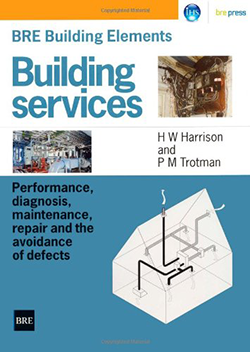Building services : performance, diagnosis, maintenance, repair and the avoidance of defects

Bibliographic Highlights
Building services : performance, diagnosis, maintenance, repair and the avoidance of defects / H W Harrison, P M Trotman. - VIII, 262 p. : bastante il. ; 30 cm
ISBN - 1-86081-424-7
Assunto - Conservação de edifícios; Reabilitação de edifícios
Synopsis
Building services is abaout the gamut of fuelled, piped, ducted, wired and mechanical facilities which extend over the whole age range of the UK's building stock.
In essence, it is the quality of heating, artificial lighting and other services, such as refuse disposal, which makes an otherwise bare carcass habitable - even efficient and enjoyable. However, things do go wrong from time to time: the boiler ceases to function, the television aerial corrodes, the pipes in hard water areas fill with calcium deposits, and, sadly, there is the occasional disaster and tragedy from carbon monoside poisoning or electrical fault.
During the routine surveys of buildings, surveyors and architects will need to identify the condition of building services: particularly deficiencies in performance resulting from outdated installations, or breakdown through wear and tear, which demand attention or further advice from specialists.
All kinds of buildings services, including space heating and cooling, ventilation systems, piped services of water and gas, refuse disposal, wired services for electricity, telephone and television, and mechanical handling systems such as lifts and escalators are, in principle, covered in this book.
The descriptions and advice given concentrate on pratical details; but there must also be sufficient discussion of principles to understand the reason for certain practices.
Both good and bad features of building services are described, and sources of further information and advice are offered. The text concentrates on those aspects with which BRE has been most heavily involved, whether through laboratory research, site investigation or development of legislation and Standards. Case studies are selected from the files of the BRE Advisory Service, the Building Research Energy Conservation Support Unit, and the former BRE Defects Prevention Unit, and represent the most frequent kinds of problems on which BRE has been consulted.
Related links





